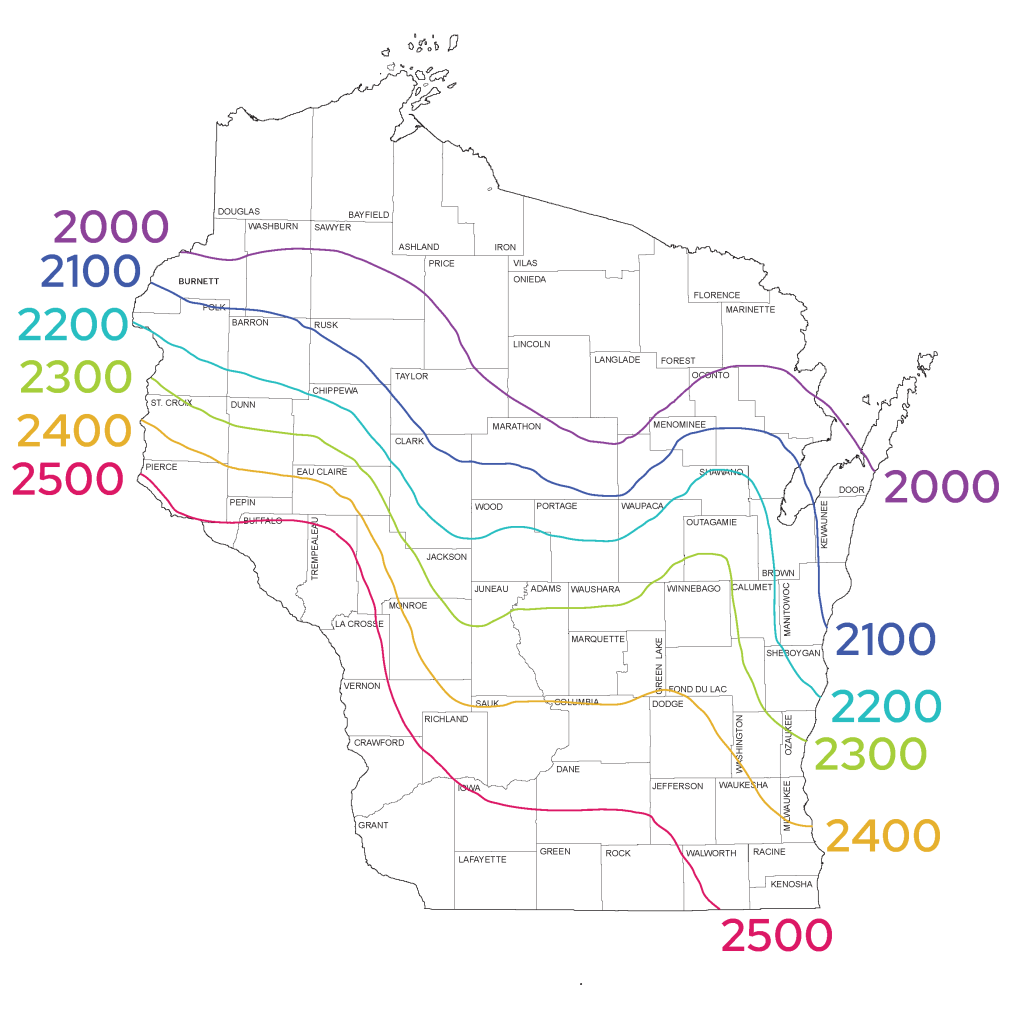Home » Nutrient application guidelines for field, vegetable, and fruit crops in Wisconsin (A2809) » Appendix A: Methods for Determining N Recommendations
Appendix A: Methods for Determining N Recommendations
Appendix A: Methods for Determining N Recommendations
Appendix A: Methods for Determining N Recommendations
Introduction
Several key components are necessary to customize fertilizer and lime recommendations to each field’s needs. The first component, a current soil test, has already been discussed in Chapter 2: Sampling soils for testing. Two other necessary components include specific information about the soil and crops to be grown.
Soils
Soil yield potential
Soil yield potential is a relative ranking of a soil’s ability to produce high corn yields along with the responsiveness of corn yield to nitrogen (N) fertilizer. Soil properties in the NRCS database were used to determine soil yield potential. All soils in the sandy soil group have a low yield potential. For yield potential rankings, these soils are called sandy (S). An organic soil has a high yield potential if the soil temperature regime is mesic and has a medium yield potential if the soil temperature regime is frigid. Three soil properties are used to determine the yield potential of loamy soils: soil drainage class, available water in the upper 60 inches of soil, and depth to bedrock. If at least one of these soil properties is limiting, then the yield potential is medium. If none of the soil properties is limiting, then the soil has a high yield potential.
Soil drainage class
Soil drainage classes that limit crop production include: excessively drained, somewhat excessively drained, poorly drained, and very poorly drained. Well-drained, moderately well drained, and somewhat poorly drained soils do not limit yield potential.
Very low (< 3 inches) and low (3–6 inches) available water capacity in the upper 60 inches of soil limit yield potential to medium. Moderate (6–9 inches), high (9–12 inches), and very high (> 12 inches) available water capacities do not limit yield potential.
Soil series
Soil series with less than 30 inches of soil over bedrock are considered shallow and limit yield potential. Shallow soils often have low or very low available water capacity.
Map units within a soil series may differ with regard to soil drainage class, available water capacity, and/or depth to bedrock. When this occurs, the soil property interpretation of the majority of the map units is used to determine soil yield potential.
Field location
In addition to soil properties, if a soil’s location has, on average, less than 2100 growing degree days (GDD, modified base 50, maximum 86, May 1 through September 30), it should be considered medium yield potential regardless of soil property limitations because the length of growing season restricts yield potential. Soils with no soil property limitations on yield potential in locations with: 1) 2100 to 2200 GDD; or 2) less than 2100 GDD and a mesic temperature regime are in a transition area; in some cases these soils are high yield potential, in others medium. In the transition area, growers and agronomists should choose the most appropriate yield potential based upon experience. Average GDD isolines for Wisconsin are provided in Figure 4.1. Loamy soils that are irrigated because of low available water capacity or that are artificially drained (e.g., tiled) because of poor drainage can be considered high yield potential if the location has more than 2200 GDD or is in a transition area. If loamy soils are limited by shallow depth to bedrock and field evaluation demonstrates that there is more than 30 inches of soil over bedrock throughout a majority of the field, then the soil can be considered high yield potential.

Figure 4.1. Average accumulated (May 1 to September 30) growing degree day (GDD) isolines for Wisconsin, 1997–2011.
The GDD map in Figure 4.1 was developed using temperature measurements, from airport automated weather stations maintained by National Weather Service and Federal Aviation Administration, that were collected and interpolated into grids by the UW Extension Ag Weather project. The accumulated GDD from May 1 through September 30 were calculated using the modified base 50, maximum 86 method used for corn growth and development. The accumulated GDD for each year from 1997 (the year UWEX Ag Weather began operating) through 2011 were averaged, and GrADS software was used to create the GDD isolines in Figure 4.1. The average GDD at any location in Wisconsin can be obtained using the location’s latitude and longitude along with the UWEX Ag Weather thermal model at:
(http://www.soils.wisc.edu/uwex_agwx/thermal_models.)
Each map unit in a soil series was evaluated individually to place it into soil group and soil yield potential categories. There are soil series where not every map unit meets the criteria to be placed in the same soil group. For example, some map units may be sandier and are grouped as S, while other map units in the same soil series are group L. In addition, for some soil series, not every map unit has identical soil properties. In some cases, this results in different interpretations for soil yield potential. Where differences in soil group or soil yield potential occur between map units in a soil series, the interpretation for the majority of the map units was used to determine the soil group and soil yield potential for the soil series. Table 4.1 provides the soil group and soil yield potential for each mapped soil series in Wisconsin. Also included in this table are the soil properties that were used to evaluate soil yield potential. Growers and agronomists who wish to create more site-specific fertilizer recommendations may do so by using the soil group and yield potential for each individual map unit. This information may be accessed here from UW and in SnapPlus nutrient management software.
If a soil series name is not known, generic N, P, K, and lime recommendations can be made. Soil testing lab staff will make an assessment of soil group based on soil organic matter content and texturing the soil by hand.

Natasha Rayne, Ph.D.
Assistant Professor and Extension Specialist – Soil Fertility and Nutrient Management
Manure placement, timing, and nitrogen credits; organic soil amendments and nutrient cycling; climate-smart and site-specific nitrogen management; improvement of nitrogen use efficiency in cereal crop production.
Last Updated: June 18, 2024




